Why a Mini Fridge Isn’t Just for Dorm Rooms Anymore
Gone are the days when mini fridges were seen solely as dorm room staples. In 2025, these compact cooling units have found a place in virtually every type of living and working space — from sleek home offices to cozy RVs. The modern mini fridge is more than just a space-saver; it’s a lifestyle enhancer. With advanced features, energy-efficient designs, and aesthetic appeal, mini fridges are redefining convenience and practicality.
Whether you’re a remote worker looking for a cold drink within arm’s reach, a frequent traveler needing portable refrigeration, or someone optimizing a small living space, there’s a mini fridge tailored to your needs. Let’s explore why this small appliance has become a big hit and how to choose the best one for your space.
Ideal Uses for Mini Fridges: Transforming Every Corner of Your Space
Mini fridges are no longer confined to college dorms. Their versatility makes them a smart addition to almost any space — whether it’s about boosting convenience, saving energy, or just adding a touch of luxury. Below are some of the most common (and some unexpected!) places where a mini fridge can be a game changer.
1. Home Office: Stay Focused, Stay Fueled
With more people working remotely than ever before, the home office has become a central hub of daily life. A mini fridge in your workspace can significantly boost your productivity by eliminating unnecessary trips to the kitchen.
How it helps:
Reduces distractions: Grabbing a drink or snack no longer means interrupting your workflow.
Promotes healthy snacking: Keep yogurt, fruit, protein drinks, or prepped meals at hand instead of relying on quick junk food.
Hydration made easy: Keep water bottles, iced coffee, or even smoothies close to your desk.
What to look for:
Quiet operation (under 40 dB): Essential in a work environment to avoid background noise during meetings.
Compact size: Choose a model that fits under or beside your desk.
Lockable door (optional): If you share your workspace, this adds a layer of privacy.
2. Guest Rooms: Hotel-Level Comfort at Home
Want to impress your overnight guests? Adding a mini fridge to your guest room makes their stay more comfortable and independent — no more midnight fridge raids in the main kitchen.
How it helps:
Offers guests the ability to store medication, baby bottles, or personal snacks.
Adds a luxury touch — especially when stocked with water bottles, juice boxes, or chocolate bars.
Perfect for short-term rentals (Airbnb) where guests expect a self-contained experience.
What to look for:
Interior lighting: For ease of use at night.
Glass-front or stylish design: Adds to room aesthetics.
Temperature control: Some guests may need cooler storage for perishables or medicines.
Add a small tray on top with cups, a water bottle, and snacks to create a mini hospitality station.
3. Garages and Workshops: Cool Convenience in Rugged Spaces
Your garage isn’t just a place to park the car — it’s often a gym, workspace, or man cave. A garage mini fridge keeps drinks and snacks accessible while you work, exercise, or unwind.
How it helps:
No need to track dirt through the house when you want a cold beverage.
Keeps sports drinks or protein shakes ready post-workout.
Stores overflow items from your main fridge, especially during holidays or parties.
What to look for:
Durable exterior and design that handles temperature fluctuations (especially in non-climate-controlled garages).
Ample storage space for bottles, cans, or extra food.
Reinforced door seals to maintain temperature despite ambient heat or cold.
Opt for a stainless steel or rugged model that can handle dust and variable temps without breaking down.
4. RVs and Camper Vans: Travel-Friendly Refrigeration
When you’re on the road, every inch of space matters — and every appliance must earn its keep. A mini fridge can be your best friend while traveling, camping, or living the #VanLife.
How it helps:
Keeps perishables safe on the go: meat, dairy, fruits, or leftovers.
Reduces dependency on ice chests or grocery stops.
Allows off-grid living with DC or solar-powered options.
What to look for:
AC/DC compatibility or dual-voltage models for flexible use.
Low power consumption (especially if running off a generator or solar panel).
Compact, portable design with handles or wheels.
Compressor-powered cooling for stable performance during movement.
If you camp often, look for a mini fridge with a freezer compartment to store ice packs or frozen meals.
Other Creative Uses Worth Mentioning:
Bedroom Mini Fridge: For late-night snacks, skincare products, or storing medication.
Entertainment Rooms/Home Bars: Perfect for chilling wine, mixers, or beer.
Tiny Homes & Studio Apartments: Saves space and often fits better with minimalist designs.
Baby Nurseries: Keep milk or formula chilled for quick access during nighttime feedings.
Features to Look For in a Mini Fridge (Buyer’s Guide)
Choosing the right mini fridge isn’t just about size — it’s about how well the appliance fits into your daily routine. From energy use to internal layout, the right combination of features can make your compact fridge a quiet, efficient, and convenient part of your space.
Energy Efficiency
If your mini fridge will run around the clock, efficiency becomes a top concern. A well-designed, energy-efficient fridge uses less electricity, generates less heat, and keeps your bills low without sacrificing performance. Many compact models are ENERGY STAR® certified, which means they’re designed to use less energy while still keeping contents cold.
Fridges with inverter compressors tend to be quieter and more efficient than standard models, as they maintain a steady internal temperature without constantly powering on and off. Some newer models also include eco modes or automatic temperature adjustments to help save energy when the fridge isn’t being accessed frequently.
When comparing options, look for models with an annual energy consumption rating on the product label. For most households, the lower the kWh/year number, the better — especially if you’re planning to place it in a bedroom, office, or RV where efficiency is essential.
Storage Layout & Interior Organization
The internal design of a mini fridge has a huge impact on how easy it is to use. A smart layout makes even a small fridge feel more spacious and functional.
Adjustable shelving is especially helpful when you need to fit items of different shapes and sizes — like tall drink bottles one day and stacked leftovers the next. Shelves made of glass are easier to clean and give a more polished look, while wire racks allow for better air circulation.
Door compartments add extra storage without taking up shelf space. Some come with can holders or gallon bottle slots, which are perfect for drinks and condiments. If you like to keep your fridge stocked with snacks, sauces, or small containers, these little details make a big difference.
Some mini fridges include a crisper drawer for storing fruits and vegetables. This is a great option if you’re using your fridge for meal prepping, or just want to keep produce fresher for longer.
A freezer compartment is another thing to consider. Compact models often include a small freezer box inside the main unit, which can handle simple tasks like making ice or storing frozen snacks. Larger models may have a separate freezer door, offering better temperature control and space for more frozen goods.
Interior lighting is often overlooked, but it adds a lot of convenience — especially in dark rooms or for nighttime use. LED lights are a common feature and use very little power while providing clear visibility inside the fridge.
Temperature Control
Being able to adjust the temperature of your fridge gives you more flexibility. Manual dials are easy to use, but digital controls provide more precise settings. If you plan to store temperature-sensitive items like dairy, medication, or certain beverages, this feature becomes especially useful.
Some mini fridges offer dual-zone cooling, which allows for different temperatures in the freezer and refrigerator sections. This helps prevent frozen items from thawing or fridge items from freezing — a common issue in single-compartment models.
Using a separate fridge thermometer can help you monitor internal conditions and make small adjustments as needed. It’s a good idea in any setting where consistent temperature is important.
Noise Level
If your mini fridge is going into a bedroom, office, or quiet area, noise level becomes a key factor. Compressor models generally offer stronger cooling, but can sometimes hum or buzz during cycles. Look for models with low-decibel ratings if peace and quiet is important to you.
Thermoelectric fridges tend to be quieter but are usually less powerful and work best in climate-controlled rooms. These are great for storing drinks, skincare, or snacks when noise is more of a concern than deep cooling.
Reviews often provide honest insights into how quiet a fridge runs. Checking customer feedback can be just as helpful as reading specs when choosing a fridge for a quiet environment.
Size and Portability
Not all mini fridges are truly “mini.” Before choosing one, measure your space — including height, width, and depth — and account for door swing and ventilation room. Capacity is usually measured in cubic feet, and most mini fridges range from 1.6 to 4.5 cu. ft. Smaller units work well under desks or in shared rooms, while larger ones are great for guest rooms, garages, or studio apartments.
If you’ll be moving the fridge around — for example, using it in an RV, camper, or temporary rental — look for lighter models with recessed or built-in handles for easier transport.
Design and Finish
Mini fridges don’t have to look like bulky utility appliances anymore. You can find models that match your room’s aesthetic, whether you prefer a minimalist matte black finish, a sleek stainless steel look, or something more playful like a retro color scheme with chrome handles.
Glass-front beverage coolers are a stylish choice for home bars or entertainment areas. Some fridges also come with reversible doors, which allow you to choose the hinge side during installation. This can make placement easier in tight spots or corner spaces.
Best Mini Fridges for Every Space & Budget
Whether you’re shopping for a compact fridge for your office, bedroom, RV, or home bar, finding the right model depends on your storage needs, space limitations, and lifestyle. Here’s a breakdown of top-rated mini fridges across three categories — budget-friendly, mid-range, and premium — with detailed insights to help you pick the best fit for your environment.
BLACK+DECKER BCRK17B Compact Refrigerator (1.7 cu. ft.)
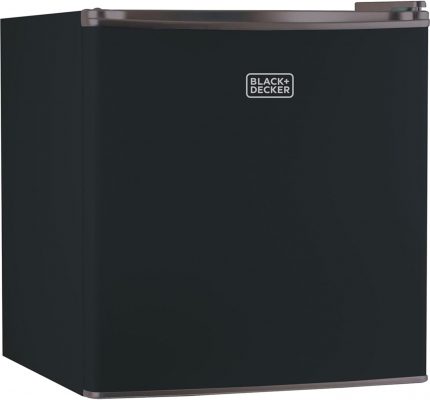
This compact, reliable fridge is a solid choice for those who want basic functionality without taking up much space. Its small footprint makes it perfect for tight areas like student dorms, home offices, or under a desk.
Despite its size, it cools quickly and consistently. Inside, it includes a single wire shelf, a small freezer compartment, and door shelving that holds cans and small bottles. The thermostat dial allows for basic temperature adjustments, which are sufficient for everyday needs like beverages, snacks, and light perishables.
Many users appreciate how quietly it runs, which makes it ideal for bedrooms or workspaces where noise is a concern. Its reversible door adds flexibility during installation, making it easier to fit into awkward corners or small nooks.
Best for: Dorms, offices, bedrooms, or anyone looking for a no-frills, compact fridge that quietly gets the job done.
Midea WHS-65LB1 Compact Refrigerator
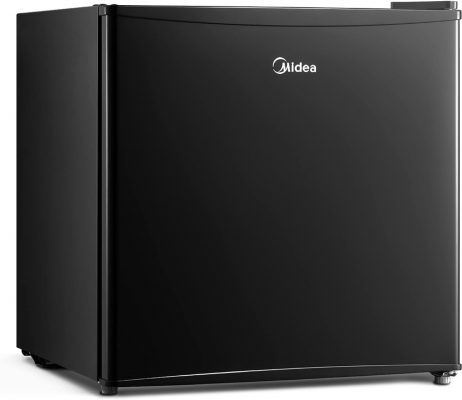
This model is designed with simplicity and energy efficiency in mind. It features a chiller compartment for items that need to be kept slightly colder, such as chocolate, dairy, or medications, though it isn’t suitable for long-term freezing.
The interior space is compact but thoughtfully arranged. There’s a removable wire shelf to help organize small items, and the door has a sectioned layout that can fit a few cans, jars, or juice boxes. It’s lightweight and easy to move, making it suitable for temporary living situations or shared accommodations.
Its energy-saving design makes it ideal for those who plan to keep it running around the clock. Because it produces very little noise and heat, it blends well into quiet areas without causing disruption.
Best for: Small bedrooms, personal offices, nurseries, or minimalist spaces where low energy usage and quiet operation are key.
Frigidaire Retro Bar Fridge with Freezer
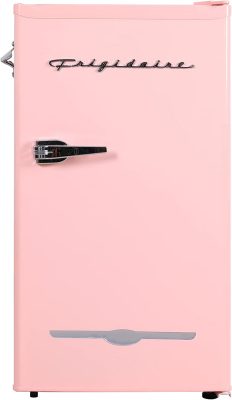
A blend of style and functionality, this retro-style mini fridge stands out with its vibrant color options and chrome finishes. But it’s not just about looks — this unit is built with practicality in mind. It includes a separate top-door freezer that works well for frozen meals or ice trays, unlike many compact fridges with inadequate freezer boxes.
Inside the refrigerator section, you’ll find adjustable shelves, a spacious crisper drawer for produce, and ample door storage for drinks and condiments. The layout is intuitive and spacious enough to handle food for one or two people, or act as a supplementary fridge in a guest suite or studio apartment.
Its design is a conversation piece in itself, making it a great addition to themed spaces like home bars, game rooms, or stylish kitchens. It runs quietly and keeps a steady temperature, which users find dependable.
Best for: Those looking for a functional mini fridge that doubles as a decorative element in home bars, guest rooms, or retro-themed interiors.
GE GDE03GGKBB Double-Door Compact Refrigerator
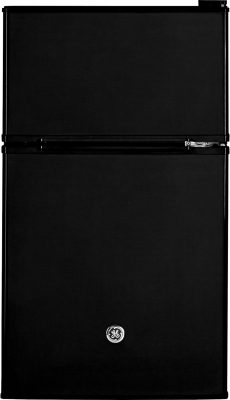
This GE model offers a well-balanced combination of efficient storage, high performance, and user-friendly features. It includes a true freezer compartment with its own door — a significant upgrade over typical mini fridge freezer boxes — and maintains freezing temperatures effectively.
The refrigerator area is spacious and thoughtfully designed, with glass shelves, a vegetable crisper drawer, and well-structured door storage. The inclusion of a light inside makes it easier to find what you need without turning on room lights, especially in guest rooms or bedrooms.
Temperature control is straightforward, and users consistently report that both sections cool evenly and maintain their settings well. It also runs quietly and looks sleek, making it a professional-looking addition to home offices or apartments.
Best for: Users who need more serious food storage in a compact form — ideal for offices, guest rooms, garages, or as a main fridge in a small living space.
NewAir 126-Can Freestanding Beverage Fridge
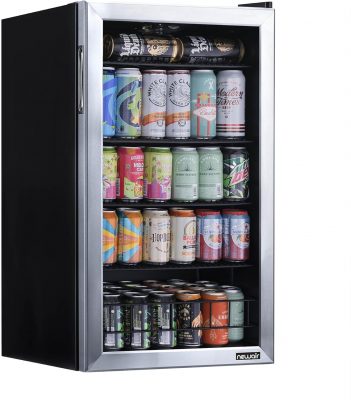
Engineered with entertaining in mind, this beverage fridge is optimized for cans and bottles rather than food storage. It’s perfect for home bars, media rooms, or outdoor kitchens where quick access to cold drinks is a priority.
With space for up to 126 cans, it’s ideal for parties or households with multiple beverage preferences. Adjustable metal racks allow you to customize the interior to fit wine bottles, sports drinks, or energy drinks of varying sizes. The digital control panel lets you fine-tune the temperature for optimal beverage cooling, and the front-facing glass door with internal LED lighting gives it a stylish, commercial feel.
The cooling system is strong and responsive, capable of chilling drinks to ice-cold levels quickly. While it’s a bit louder than standard fridges due to its powerful compressor, this is rarely an issue in high-activity spaces like game rooms.
Best for: Beverage lovers, entertainers, and families who want a dedicated drink station that looks great and performs well.
Dometic CFX3 Portable Refrigerator
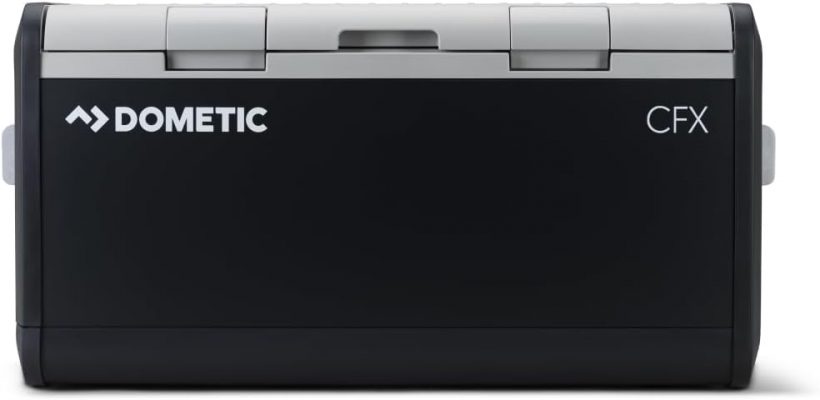
This rugged, feature-rich unit is designed for life on the move. Often used in RVs, camper vans, boats, or off-grid setups, the Dometic CFX3 delivers dual-zone cooling and freezing in a single, portable form.
What sets this model apart is its durability and smart technology. The build is strong enough to handle bumpy rides and outdoor exposure, while the interior compartments can be configured for fridge-only, freezer-only, or both. Its efficient compressor runs on AC, DC, or even solar power, making it incredibly flexible.
One standout feature is the app-controlled temperature adjustment. Users can monitor and control the fridge remotely, which is a huge advantage when traveling. It also has a USB port for charging devices, turning it into a multitasking companion for camping or road trips.
Best for: Travelers, outdoor enthusiasts, and RV owners who need a reliable, durable, and tech-friendly portable fridge with real cooling and freezing capability.
Maintenance Tips & Energy-Saving Tricks for Mini Fridges
Mini fridges are low-maintenance appliances, but like any machine, they perform best when cared for properly. Whether you’re using your fridge in a home office, garage, bedroom, or RV, taking a few simple steps can extend its life, improve efficiency, and help you avoid costly repairs.
Keep It Clean — Inside and Out
A clean fridge not only runs better, but it also prevents unpleasant odors and food contamination.
Interior Cleaning:
Wipe down the interior every month using a soft cloth and a mild mixture of warm water and baking soda. Avoid harsh chemicals that can leave behind toxic residues or damage surfaces.
Remove and clean shelves, drawers, and door bins regularly. Let them dry completely before reinstalling to prevent mold growth.
Check the drain hole (if present) and clear any debris to avoid water buildup.
Exterior Maintenance:
Dust the back and underside of the fridge, especially the coils, if they’re exposed. Accumulated dust reduces energy efficiency and strains the compressor.
Use a vacuum or soft brush to gently clean these areas every 3–6 months.
Defrost When Needed
Many mini fridges have manual defrost systems, meaning frost buildup inside the freezer compartment needs to be removed manually.
Defrost when frost reaches about ¼ inch thick. Turn off the unit, remove all contents, and place towels to absorb the melting water.
Never use sharp objects to remove ice. Let it melt naturally or speed up the process with a bowl of hot water placed inside.
After defrosting, wipe the interior dry before turning the fridge back on.
Frost buildup decreases cooling efficiency and reduces available space, so keeping it in check is important.
Ensure Proper Placement
Where you place your mini fridge plays a big role in its performance and energy consumption.
Leave at least 2–4 inches of space behind and on the sides of the fridge for ventilation. Poor airflow forces the compressor to work harder.
Avoid placing the fridge near heat sources like ovens, radiators, or direct sunlight.
Set the fridge on a level surface. Uneven positioning can cause the door to not seal properly or put stress on internal components.
Maintain a Consistent Temperature
Keeping the fridge at the right temperature ensures food safety and energy efficiency.
Use a fridge thermometer to monitor internal temperatures. Aim for 35–40°F (1.7–4.4°C) for the fridge section and 0°F (-18°C) for the freezer.
Don’t set it colder than necessary — this wastes energy and may cause food to freeze unintentionally.
Avoid frequent temperature adjustments unless absolutely necessary.
In warm or fluctuating environments like garages or RVs, it’s especially important to check the internal temperature regularly.
Don’t Overload or Underload
How you fill your fridge affects how efficiently it runs.
Avoid overstuffing the fridge. Air needs to circulate to keep everything evenly cooled.
At the same time, don’t leave it too empty either. A well-stocked fridge retains cold better than an empty one because the items help stabilize the temperature.
If you’re not using the fridge often, place water bottles inside to help maintain consistent cooling.
Keep the Door Sealed Tight
The door seal (also called a gasket) is essential for keeping cold air inside.
Check the seal by closing the door on a piece of paper. If the paper slides out easily, the seal may need replacing.
Clean the gasket monthly with warm soapy water to prevent mold, crumbs, or grime from weakening the seal.
Don’t leave the door open longer than necessary. The longer it stays open, the more energy the fridge uses to re-cool.
Turn Off When Not in Use
If you’re going on vacation or don’t need the mini fridge for a while:
Empty all items and unplug the unit.
Leave the door slightly open to prevent odors or mold.
Clean and dry the interior thoroughly before storing.
This is especially important for portable models used seasonally in RVs, boats, or cabins.
Use an Energy-Efficient Power Setup
Plug the fridge directly into the wall. Avoid long extension cords or overloaded power strips, which can cause voltage drops or safety issues.
If you’re using a power strip, choose one designed for appliances and rated for the fridge’s wattage.
Some fridges have “eco” or “power-saving” modes — use these when constant cooling isn’t necessary, like at night or during cooler months.
Monitor for Signs of Trouble
Early signs of problems can often be addressed before they become major issues.
Listen for unusual noises — grinding, clicking, or buzzing could mean the compressor is struggling.
Check for condensation or water pooling inside — it might indicate a blocked drain or poor door seal.
Uneven cooling or warm spots can suggest airflow issues or a failing thermostat.
If you notice these signs, consult the user manual or consider a professional repair, especially if the fridge is still under warranty.
Don’t Ignore the Manual
Every model has its own quirks and maintenance needs. The user manual offers valuable guidance on:
Recommended cleaning procedures
Defrosting instructions
Storage guidelines
Troubleshooting tips
Keep it handy or download a copy from the manufacturer’s website if you’ve misplaced it.
FAQ: Mini Fridges
1. Can I use a mini fridge as my main refrigerator?
Yes, especially if you live alone or in a small space. Larger mini fridges (3+ cu. ft.) with separate freezer compartments can handle everyday use for essentials.
2. Is it safe to keep a mini fridge in a bedroom?
Absolutely. Modern models are designed to be quiet and energy-efficient. Just make sure the fridge is placed on a level surface and not overloaded.
3. How long do mini fridges typically last?
With regular maintenance, a quality mini fridge can last 6 to 10 years. Keeping it clean and avoiding overuse of the compressor extends its lifespan.
4. Do mini fridges consume a lot of electricity?
Not usually. Most compact fridges are energy-efficient, especially if they’re ENERGY STAR® certified. On average, they use less power than full-sized refrigerators.
5. Can I keep a mini fridge in a garage or outdoor space?
Yes, but it depends on the model. Choose one built to handle temperature fluctuations if placing it in an unheated space. Insulated or garage-ready fridges work best in these conditions.
6. Do mini fridges need to be defrosted?
Some do, especially if they have manual defrost freezers. Defrosting prevents ice buildup and keeps the fridge working efficiently.
7. What size mini fridge is right for me?
Under 2.0 cu. ft.: Best for desktops, dorms, or tight spaces.
2.0–3.5 cu. ft.: Good for offices, bedrooms, or small apartments.
3.5+ cu. ft.: Ideal as a main fridge for individuals or for shared spaces.
Conclusion: Small Appliance, Big Impact
Mini fridges have evolved far beyond their old role as basic dorm room coolers. Today, they’re practical, stylish, and versatile appliances that fit seamlessly into a wide variety of spaces — from home offices and guest rooms to RVs, garages, and tiny homes. Whether you need a convenient place to store drinks, a dedicated spot for snacks, or an efficient solution for small living areas, there’s a mini fridge designed to meet your needs.
Choosing the right model means looking beyond size. Consider how energy-efficient it is, how well the interior is laid out, how quiet it runs, and whether it fits your lifestyle. With proper maintenance and thoughtful use, a mini fridge can serve you reliably for years while saving space and energy.
From budget-friendly basics to premium options with advanced features, the perfect compact refrigerator is out there — ready to make your everyday life just a little cooler.
